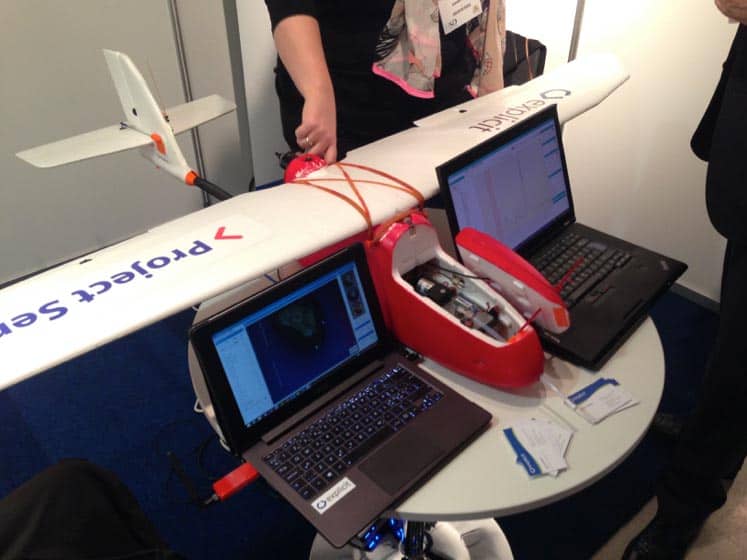
Today the value of the civilian drone market is estimated at US $7bn and is projected to grow to $12bn in 2023. This means investment in drone technology is expected to grow annually from US $6.5 billion a year, to US $11.5 billion over the next decade.*
TUSExpo 2015 – Small drone used to monitor vessel emissions.
There is no doubt that drone technology is an emerging market, offering the world a variety of new uses in a range of areas: agriculture, geo-mapping, event broadcasting, real estate, aerial delivery, industrial surveillance, search and rescue, law enforcement. Acknowledging not only the opportunities but also the challenges posed by this technology globally, I travelled to The Netherlands in early February to attend The Unmanned Systems Expo 2015.
During these 3 days of exciting exhibitions and conferences, I learned about the latest market trends; the difficult challenges currently faced by the industry and more importantly, the role that Jersey can play as a ‘test-bed’ jurisdiction.
I also discovered that drone technology is complex and at times highly paradoxical, which inspired me to write this blog post!
Whereas the word ‘drone’ is commonly used by the public and the media, the industry has not yet managed to agree on a common term. At the moment, they use a diversity of seemingly interchangeable acronyms such as UAVs (Unmanned Aerial Vehicles), UAS (Unmanned Aerial Systems), RPAS (Remote Piloted Aerial Systems) and so on.
Today’s drone expansion within the civilian market, lead by the different drone applications available, is a consequence of the efforts made by the defense industry to take this technology to the next level. However, the civilian industry avoids using the word drone, precisely because of its association with the defense industry.
Drones are almost as old as traditional manned flights, their use dating back to the First World War. Despite this, the drone industry is still seen as a very young one. It wasn’t until the beginning of the 21st century that the drone market started to expand, introducing new drones of varied shapes, weights, and uses to the market.
The drone industry has marketed its products as recreational toys with the successful launch of the DJI Phantom I. The civilian market has evolved however, moving from designing recreational toys to developing commercial solutions able to drive important efficiencies for businesses.
Although it may seem that drone innovation is all about flying capacity and the drone itself, today’s industry doesn’t focus very much on the drone (which uses classic aviation principles) but on its sensors and equipment, and this is the area where true innovation has taken place.
Whereas the industry has identified the collection of data as the real value of drone technology, it is estimated that only 2% of data collected with drones is relevant for its user. This has forced the industry to develop solutions able to capture and process only relevant data before it is transferred to its user.
The latest technology developments were designed to increase the use of drones, but currently the industry faces the challenge of solutions to prevent drone usage. This is occurring both in civilian contexts, with drones near airports being a key problem, and in the defense sector as seen by the new Chinese laser system to shoot down drones.
As with other new technologies, drone technology has not only opened new horizons for security and commercial applications but also the potential for negligent and illegal use.
At the moment, it is believed that drones need to be kept separate from the commercial airspace for security reasons. However, the drone industry is now developing technology to enable drones to share the airspace with the rest of commercial air traffic. Indeed, it is believed that ‘drone integration’ will be a reality in the future.
The use of civilian drones is perceived as a security and privacy threat with the drone’s pilot assuming sole responsibility. National public authorities have to play a part too though, and still have a long way to go in fostering public awareness, education and prevention of criminal activities.
*A Blessing in the Skies? Challenges and Opportunities in Creating Space for UAVs in the Netherlands. The Hague Security Delta. 2015.



